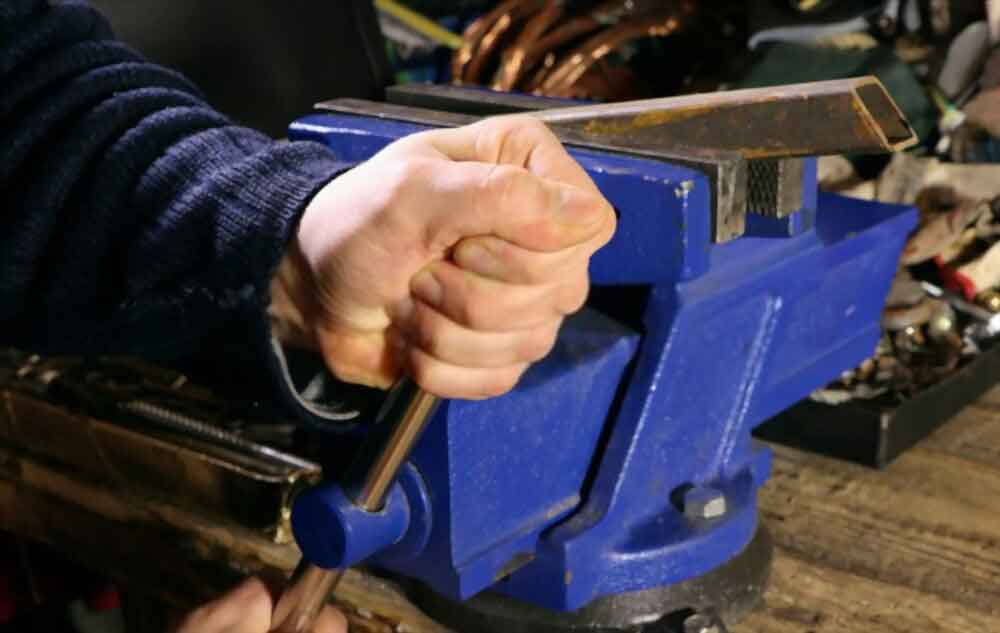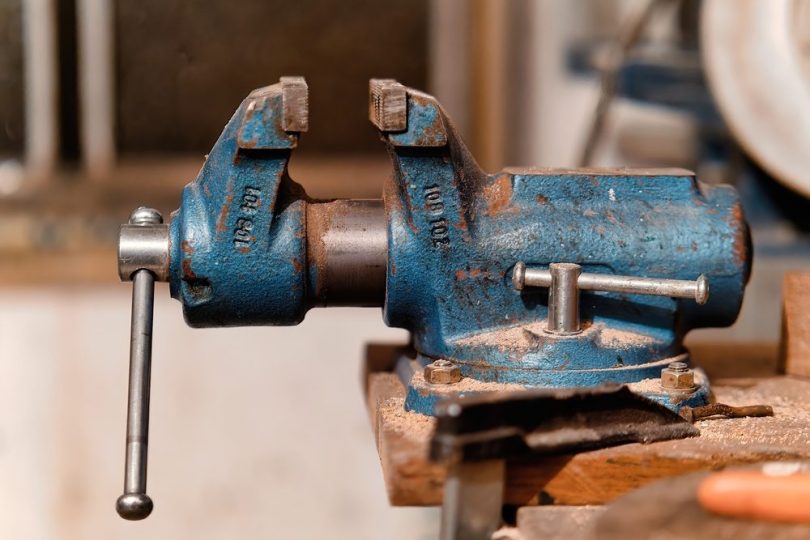A vise is an essential instrument in carpentry and metalworking applications. Bench vises of different types can be attached directly to a workbench to hold the work piece during particular activities, for example, sawing, arranging, and drilling.
This device is versatile whether you are working with metal, wood or any other materials. It offers stability you need to get the job done with so much creativity and accuracy. Bench vise uses are numerous, and amongst all the features it comes equipped with directly from the company, several carpenters and woodworkers have also developed their own special way. So if you want to know all the different bench vise uses and more, keep reading.
Bench Vise Uses

This device comprising of two parallel jaws for holding a workpiece; one of the jaws is settled and the other portable by a screw, a lever, or a cam. It is used for holding a workpiece amid hand tasks, for example, filing, sawing, gluing, or hammering, the vise can be forever bolted to a bench. There are various types namely;
- Engineer’s Vise (Metalworking)
- Woodworking
- Vacuum
- Clamp-on
- Pipe
- Machine
1. When You Use a Saw
A bench vise can be exceedingly useful when you utilize a saw to cut wood or metal for your different DIY ventures. In the event that vise is utilized, you will have the capacity to hold the bit of material effectively as you cut it. Trust me it is a solid device that can get a handle on the bit of wood or metal you need as you work your way through it. With a bench vise, you can say bye-bye to utilizing your free hand to hold a metal or wooden material set up.
2. When You Need to Work with a Drill
Do you need a power drill for a venture? Get a bench vise with solid construction to complete the task effectively. This is a normal activity associated with different territories like pipes, carpentry, electrical fittings, and interior decors. Drilling requires basic dependability and exactness. A bench vise can be utilized to hold the driller at the exact position and in this way drill, the holes required.
It gives the fundamental soundness for the drilling instrument utilized. In this manner, the utilization of bench vises has turned out to be inescapable for penetrating purposes. For novices who are not accustomed to drilling, a bench vise may be the solution to your troubles.
3. For a Metalworking Project
When you have a metal working project to work on, then a bench vise is the best tool for you. Most bench vises include materials for cutting several types of metals. For an ideal cut toward one side of a metal piece, the opposite end ought to obviously be held firmly. In such applications, bench vises serve best.
Bench vises hold anything you need in place. In the event that you want to bend some iron rods, you will place a metal template to the jaw of the vise, tighten it up, and then you are all set to bend your iron rods.
4. For Woodworking Jobs
In most instances, carpentry works include the utilization of glue for the completing touch. There must be an additional weight separated from the gravitational power, to hold the pieces together, until they stick dry. This was usually done by placing heavy objects on the pieces until they stick and dry properly. But as time changed, and the shape of woodworking evolved, weight needed to be places in more strategic locations. A vise can prevent you from getting affected by woodworking hazards.
With the use of a bench vise, one does not have to worry about this as it will hold it in whatever manner they carpenter needs it to until it stays. For this, holding the pieces or parts utilizing a wood vise is best advised. Likewise, it rushes fast drying/staying of the glue with the material. Aside from the conjunction with different carpentry tools, any work that requires such an application can be supported with the utilization of vise.
Gluing
On the off chance that you at any point needed to put something together utilizing glue, you realize that it is so hard to discover something to hold your item immovably while the glue dries totally. The vise comes in handy, it will not just hold the item together but with much stability. The vise is very strong. Hence, it will hold the item in place for the wood to come together as strong as you desire. Having your item steady in bench vise’s jaws enables it to dry appropriately and hold the ideal structure.
Removing Nails from a Wooden Workpiece
Removing nails from a wooden workpiece can be a lot of troubles considering the wood have to be held firm with a stable hand, it requires a lot of strength to pull through but with a vise, it becomes much easier, because then the carpenter just has to install the vise and use that to hold it firmly in place; so pulling all the nails out becomes easy and no hassles occur.
5. As You Need a Workbench
A bench vise in a general sense serves all that a workbench does-giving a stronghold. For every valid reason, bench vises can supplant workbenches, contingent upon the material, size and devices utilized. An ideal work feeling can, consequently, be given by the agreeable utilization of a bench vise, wherever vital.
6. For Cutting an Electric Conduit
In electrical works, cutting plays a pivotal job. Slicing an electrical channel must be sufficiently secure with the goal that a shrewd cut is made. Holding the electrical conductor is very critical and can be best done utilizing a bench vise. There are procedures in cutting an electric conduit with a vise, and they are listed below.
- First thing you want to do is to bend and load the conduit into the vise
- Now, make sure to secure it very well, because if it moves out of place it can be an issue
- Though you want to really tighten the vise, you do not over tighten the vise so it will not damage the conduit
7. If You Need to Remove a Bearing
Should you not have a bearing puller accessible and need to evacuate an armature bearing, you’re in luck! You can really utilize a vise accessible at the time to evacuate an armature bearing on the off chance that you don’t have the bearing puller or if there isn’t sufficient space between the bearing and the armature.
There are procedures in removing a bearing with a vise.
- Position the armature body safely in the vise with the goal that its bearing sticks out one end. Make certain not to harm the armature fan in the vise.
- Wedge your pry bars or screwdrivers cautiously behind the armature bearing.
- Apply equal weight to the two sides of the bearing, and influence it off of the armature. The bearing should fly off of the armature with little power.
8. On a Sanding Job
The completing touch in numerous applications like painting, coating and so forth is given to the surfaces utilizing sandpaper. Scouring sandpaper against a material gives a smooth completion however takes a great deal of your time out. A legitimate course of action can help the briskness of the sanding procedure. That is, the concerned material viz., door or flame broil, ought to be settled appropriately on the work territory, in any case.
Clearly, bench vises are utilized here as well. Additionally, you get the opportunity to defend your hands just as the material under work. Utilizing a vise can dispense with the trouble you may be facing while at the same time searching for a safe position before you take a shot at the task.
9. An Unconventional Use: Cracking Nuts (Without a Nutcracker)
If you don not have a nutcracker, no need to worry if you have a bench vise, as getting creative with the vise is fun and makes the task easy. It is quite unconventional to use the vise to crack nuts; it just shows how versatile the vise is. Place the nut in between the vise and tighten the vise to crack the nut.
Safety Measures to Abide by When Using a Vise
- Do not repair a vise by brazing or welding
- Do not apply too much pressure at the vise jaw corner
- Do not weld any metal to the base of the vise
- Do not bend a heavy metal on a light vise
- Do not cut into the jaws of the vise
- Do not hammer the handle to tighten beyond hand pressure
- Never take the jaw of the vise to be an anvil
- Discontinue the use of any vise that has cracks
- Do not open the vise wider than they were designed to use.
There aren’t numerous tools whose utilization is as wide as it is the situation with a bench vise. Subsequently, in the wake of having your bench vise introduced, start getting a charge out of the universe of craftsmanship. With a tool as versatile as the bench vise, you can do nearly anything.








